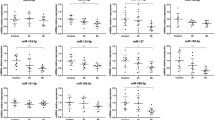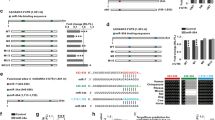Abstract
The dopamine transporter (DAT) is involved in the regulation of extracellular dopamine levels. A 40-bp variable-number tandem repeat (VNTR) polymorphism in the 3′-untranslated region (3′UTR) of the DAT has been reported to be associated with various phenotypes that are involved in the aberrant regulation of dopaminergic neurotransmission. In the present study, we found that miR-137 and miR-491 caused a marked reduction of DAT expression, thereby influencing neuronal dopamine transport. Moreover, the regulation of miR-137 and miR-491 on this transport disappeared after the DAT was silenced. The miR-491 seed region that is located on the VNTR sequence in the 3′UTR of the DAT and the regulatory effect of miR-491 on the DAT depended on the VNTR copy-number. These data indicate that miR-137 and miR-491 regulate DAT expression and dopamine transport at the post-transcriptional level, suggesting that microRNA may be targeted for the treatment of diseases associated with DAT dysfunction.





Similar content being viewed by others
References
Pramod AB, Foster J, Carvelli L, Henry LK. SLC6 transporters: structure, function, regulation, disease association and therapeutics. Mol Aspects Med 2013, 34: 197–219.
Hitri A, Hurd YL, Wyatt RJ, Deutsch SI. Molecular, functional and biochemical characteristics of the dopamine transporter: regional differences and clinical relevance. Clin Neuropharmacol 1994, 17: 1–22.
Iversen L. Neurotransmitter transporters and their impact on the development of psychopharmacology. Br J Pharmacol 2006, 147(Suppl 1): S82–88.
Nikolaus S, Antke C, Hautzel H, Mueller HW. Pharmacological treatment with L-DOPA may reduce striatal dopamine transporter binding in in vivo imaging studies. Nuklearmedizin 2016, 55: 21–28.
Wise RA. Dopamine, learning and motivation. Nat Rev Neurosci 2004, 5: 483–494.
McHugh PC, Buckley DA. The structure and function of the dopamine transporter and its role in CNS diseases. Vitam Horm 2015, 98: 339–369.
Otani S, Bai J, Blot K. Dopaminergic modulation of synaptic plasticity in rat prefrontal neurons. Neurosci Bull 2015, 31: 183–190.
Block ER, Nuttle J, Balcita-Pedicino JJ, Caltagarone J, Watkins SC, Sesack SR, et al. Brain region-specific trafficking of the dopamine transporter. J Neurosci 2015, 35: 12845–12858.
Cheng MH, Bahar I. Molecular mechanism of dopamine transport by human dopamine transporter. Structure 2015, 23: 2171–2181.
Mergy MA, Gowrishankar R, Davis GL, Jessen TN, Wright J, Stanwood GD, et al. Genetic targeting of the amphetamine and methylphenidate-sensitive dopamine transporter: on the path to an animal model of attention-deficit hyperactivity disorder. Neurochem Int 2014, 73: 56–70.
Sery O, Paclt I, Drtilkova I, Theiner P, Kopeckova M, Zvolsky P, et al. A 40-bp VNTR polymorphism in the 3′-untranslated region of DAT1/SLC6A3 is associated with ADHD but not with alcoholism. Behav Brain Funct 2015, 11: 21. doi:10.1186/s12993-015-0066-8.
Ettinger U, Merten N, Kambeitz J. Meta-analysis of the association of the SLC6A3 3′-UTR VNTR with cognition. Neurosci Biobehav Rev 2016, 60: 72–81.
Sano A, Kondoh K, Kakimoto Y, Kondo I. A 40-nucleotide repeat polymorphism in the human dopamine transporter gene. Hum Genet 1993, 91: 405–406.
VanNess SH, Owens MJ, Kilts CD. The variable number of tandem repeats element in DAT1 regulates in vitro dopamine transporter density. BMC Genet 2005, 6: 55. doi:10.1186/1471-2156-6-55.
Vandenbergh DJ, Persico AM, Hawkins AL, Griffin CA, Li X, Jabs EW, et al. Human dopamine transporter gene (DAT1) maps to chromosome 5p15.3 and displays a VNTR. Genomics 1992, 14: 1104–1106.
Jeong SH, Choi KS, Lee KY, Kim EJ, Kim YS, Joo EJ. Association between the dopamine transporter gene (DAT1) and attention deficit hyperactivity disorder-related traits in healthy adults. Psychiatr Genet 2015, 25: 119–126.
Sambataro F, Podell JE, Murty VP, Das S, Kolachana B, Goldberg TE, et al. A variable number of tandem repeats in the 3′-untranslated region of the dopamine transporter modulates striatal function during working memory updating across the adult age span. Eur J Neurosci 2015, 42: 1912–1918.
Bartel DP. MicroRNAs: genomics, biogenesis, mechanism, and function. Cell 2004, 116: 281–297.
Ambros V. The functions of animal microRNAs. Nature 2004, 431: 350–355.
Zhou S, Ding F, Gu X. Non-coding RNAs as emerging regulators of neural injury responses and regeneration. Neurosci Bull 2016, 32: 253–264.
Duan J. Path from schizophrenia genomics to biology: gene regulation and perturbation in neurons derived from induced pluripotent stem cells and genome editing. Neurosci Bull 2015, 31: 113–127.
Lewis BP, Burge CB, Bartel DP. Conserved seed pairing, often flanked by adenosines, indicates that thousands of human genes are microRNA targets. Cell 2005, 120: 15–20.
Betel D, Wilson M, Gabow A, Marks DS, Sander C. The microRNA.org resource: targets and expression. Nucleic Acids Res 2008, 36: D149–153.
Wang L, Jia XJ, Jiang HJ, Du Y, Yang F, Si SY, et al. MicroRNAs 185, 96, and 223 repress selective high-density lipoprotein cholesterol uptake through posttranscriptional inhibition. Mol Cell Biol 2013, 33: 1956–1964.
Jiang H, Zhang J, Du Y, Jia X, Yang F, Si S, et al. microRNA-185 modulates low density lipoprotein receptor expression as a key posttranscriptional regulator. Atherosclerosis 2015, 243: 523–532.
Heckman KL, Pease LR. Gene splicing and mutagenesis by PCR-driven overlap extension. Nat Protoc 2007, 2: 924–932.
Ciliax BJ, Drash GW, Staley JK, Haber S, Mobley CJ, Miller GW, et al. Immunocytochemical localization of the dopamine transporter in human brain. J Comp Neurol 1999, 409: 38–56.
Rothman RB, Baumann MH, Prisinzano TE, Newman AH. Dopamine transport inhibitors based on GBR12909 and benztropine as potential medications to treat cocaine addiction. Biochem Pharmacol 2008, 75: 2–16.
Garcia-Olivares J, Torres-Salazar D, Owens WA, Baust T, Siderovski DP, Amara SG, et al. Inhibition of dopamine transporter activity by G protein betagamma subunits. PLoS One 2013, 8: e59788.
Jones SR, Gainetdinov RR, Jaber M, Giros B, Wightman RM, Caron MG. Profound neuronal plasticity in response to inactivation of the dopamine transporter. Proc Natl Acad Sci USA 1998, 95: 4029–4034.
Blum K, Oscar-Berman M, Barh D, Giordano J, Gold M. Dopamine genetics and function in food and substance abuse. J Genet Syndr Gene Ther 2013, 4. doi:10.4172/2157-7412.1000121.
Baik JH. Dopamine signaling in reward-related behaviors. Front Neural Circuits 2013, 7: 152. doi:10.3389/fncir.2013.00152.
Velazquez-Sanchez C, Garcia-Verdugo JM, Murga J, Canales JJ. The atypical dopamine transport inhibitor, JHW 007, prevents amphetamine-induced sensitization and synaptic reorganization within the nucleus accumbens. Prog Neuropsychopharmacol Biol Psychiatry 2013, 44: 73–80.
Vaughan RA, Foster JD. Mechanisms of dopamine transporter regulation in normal and disease states. Trends Pharmacol Sci 2013, 34: 489–496.
Eriksen J, Jø rgensen TN, Gether U. Regulation of dopamine transporter function by protein-protein interactions: new discoveries and methodological challenges. J Neurochem 2010, 113: 27–41.
Sager JJ, Torres GE. Proteins interacting with monoamine transporters: current state and future challenges. Biochemistry 2011, 50: 7295–7310.
Zhao Y, Terry DS, Shi L, Quick M, Weinstein H, Blanchard SC, et al. Substrate-modulated gating dynamics in a Na+-coupled neurotransmitter transporter homologue. Nature 2011, 474: 109–113.
Barreto-Valer K, Lopez-Bellido R, Macho Sanchez-Simon F, Rodriguez RE. Modulation by cocaine of dopamine receptors through miRNA-133b in zebrafish embryos. PLoS One 2012, 7: e52701.
Strazisar M, Cammaerts S, van der Ven K, Forero DA, Lenaerts AS, Nordin A, et al. MIR137 variants identified in psychiatric patients affect synaptogenesis and neuronal transmission gene sets. Mol Psychiatry 2015, 20: 472–481.
Olde Loohuis NF, Nadif Kasri N, Glennon JC, van Bokhoven H, Hebert SS, Kaplan BB, et al. The schizophrenia risk gene MIR137 acts as a hippocampal gene network node orchestrating the expression of genes relevant to nervous system development and function. Prog Neuropsychopharmacol Biol Psychiatry 2016. doi:10.1016/j.pnpbp.2016.02.009.
Ma G, Yin J, Fu J, Luo X, Zhou H, Tao H, et al. Association of a miRNA-137 polymorphism with schizophrenia in a Southern Chinese Han population. Biomed Res Int 2014, 2014: 751267. doi:10.1155/2014/751267.
Shen H, Wang L, Ge X, Jiang CF, Shi ZM, Li DM, et al. MicroRNA-137 inhibits tumor growth and sensitizes chemosensitivity to paclitaxel and cisplatin in lung cancer. Oncotarget 2016. 7: 20728-20742.
Neault M, Mallette FA, Richard S. miR-137 modulates a tumor suppressor network-inducing senescence in pancreatic cancer cells. Cell Rep 2016, 14: 1966–1978.
Liang ML, Hsieh TH, Ng KH, Tsai YN, Tsai CF, Chao ME, et al. Downregulation of miR-137 and miR-6500-3p promotes cell proliferation in pediatric high-grade gliomas. Oncotarget 2016, 7:19723–19737.
Sun J, Zheng G, Gu Z, Guo Z. MiR-137 inhibits proliferation and angiogenesis of human glioblastoma cells by targeting EZH2. J Neurooncol 2015, 122: 481–489.
Ivashchenko DV, Shuvalov SA, Chuprova NA, Kibitov AO. The association of polymorphisms in DAT (40 bp VNTR, C > T 3′UTR) and DBH (−1021 C/T) genes with the severe complications of alcohol withdrawal state. Psychiatr Genet 2015, 25: 268–269.
Stolf AR, Szobot CM, Halpern R, Akutagava-Martins GC, Muller D, Guimaraes LS, et al. Crack cocaine users show differences in genotype frequencies of the 3′UTR variable number of tandem repeats of the dopamine transporter gene (DAT1/SLC6A3). Neuropsychobiology 2014, 70: 44–51.
Feher A, Juhasz A, Pakaski M, Kalman J, Janka Z. Association between the 9 repeat allele of the dopamine transporter 40 bp variable tandem repeat polymorphism and Alzheimer’s disease. Psychiatry Res 2014, 220: 730–731.
Giana G, Romano E, Porfirio MC, D’Ambrosio R, Giovinazzo S, Troianiello M, et al. Detection of auto-antibodies to DAT in the serum: interactions with DAT genotype and psycho-stimulant therapy for ADHD. J Neuroimmunol 2015, 278: 212–222.
Brown BK, Murrell J, Karne H, Anand A. The effects of DAT1 genotype on fMRI activation in an emotional go/no-go task. Brain Imaging Behav 2016. doi:10.1007/s11682-016-9516-7.
Kasparbauer AM, Rujescu D, Riedel M, Pogarell O, Costa A, Meindl T, et al. Methylphenidate effects on brain activity as a function of SLC6A3 genotype and striatal dopamine transporter availability. Neuropsychopharmacology 2015, 40: 736–745.
Li X, Liu Y, Granberg KJ, Wang Q, Moore LM, Ji P, et al. Two mature products of MIR-491 coordinate to suppress key cancer hallmarks in glioblastoma. Oncogene 2015, 34: 1619–1628.
Zheng G, Jia X, Peng C, Deng Y, Yin J, Zhang Z, et al. The miR-491-3p/mTORC2/FOXO1 regulatory loop modulates chemo-sensitivity in human tongue cancer. Oncotarget 2015, 6: 6931–6943.
Moore LM, Zhang W. MIR-491: CDKN2A tumor suppressor co-pilot. Oncoscience 2015, 2: 825–826.
Acknowledgments
This work was supported by grants from the National Postdoctoral Science Foundation, China (2014M552219), the Natural Science Foundation of Guangdong Province, China (2015A030313889, 2015A030401013, 2014A030313709, and 2014A030313710), the Science and Technology Planning Project of Shenzhen Municipality, China (ZDSYS201504301045406, JCYJ20150403110829621, JCYJ20150403091443301, JCYJ20140415162542975, JCYJ20140415162338855, JCYJ20140828163634004, and JCYJ20120616144352139), and the Health and Family Planning Commission Project of Shenzhen Municipality, China (201401026).
Author information
Authors and Affiliations
Corresponding authors
Rights and permissions
About this article
Cite this article
Jia, X., Wang, F., Han, Y. et al. miR-137 and miR-491 Negatively Regulate Dopamine Transporter Expression and Function in Neural Cells. Neurosci. Bull. 32, 512–522 (2016). https://doi.org/10.1007/s12264-016-0061-6
Received:
Accepted:
Published:
Issue Date:
DOI: https://doi.org/10.1007/s12264-016-0061-6




